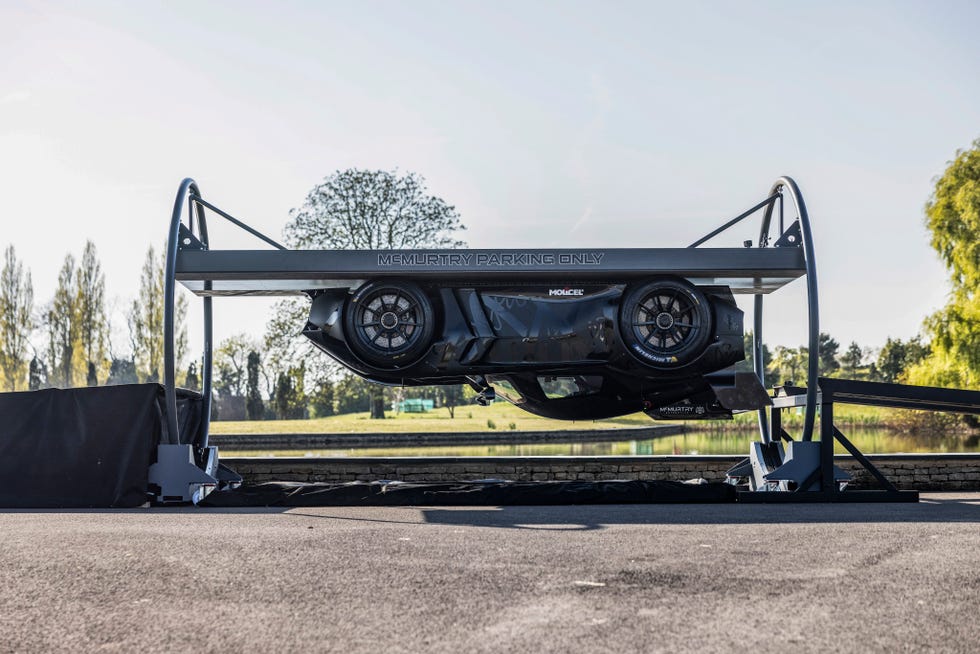Car enthusiasts have often speculated that many racing cars produce enough downforce to drive upside down without crashing. Earlier this month, the British boffins at McMurtry made that dream a reality with their all-electric track-day monster called the Spéirling (Irish Gaelic for thunderstorm). Thanks to its downforce-on-demand system—with fans that “suck” the car into the tarmac—the team inverted the Spéirling, and left it happily sitting upside down at 0 mph. We’ll attach the video of the spectacular proof of concept, as it’s one of the most incredible demonstrations of automotive technology that we’ve ever seen.
How Does It Work?
As the name suggests, downforce-on-demand provides constant downforce at any speed. The keen among you will know that McMurtry isn’t the first to come up with this fan concept, and that’s for good reason. Most high-downforce racing cars generate downforce linearly, meaning that as speed increases, so does downforce. This makes it unpredictable, as there’s a crossover point when slowing down where you’ll start to rely on mechanical grip instead of the aerodynamic safety blanket.
The Spéirling utilizes two fans spinning at up to 23,000 rpm to produce 4,409 pounds of downforce—roughly double the car’s curb weight—from a standstill. You don’t have to be a mathematician to realize that should give it the ability to drive upside down. Those fans, however, make it so that despite the Spéirling’s electric powertrain, it’s not what we’d call quiet. Let’s just say it’d be right at home sitting next to an F16 on the deck of an aircraft carrier.
There’s also the question of getting an internal combustion engine to run properly while inverted. While gravity isn’t a cruel and unpredictable mistress, it presents unique challenges with the engine’s oil system; a conventional wet-sump oil system still relies on gravity to drain oil back down to the pan. That’s why Ferrari recently designed its own bespoke dry-sump oil system that’s pressurized to keep oil flowing where it needs to go. Even still, our friends at MotorTrend report that there’s a risk that engine oil not scavenged back into the sump reservoir can seep past the cylinder and risk hydrolocking the engine. Not good.
If you’re curious about the modifications needed for an electric powertrain to work upside down, the answer is… well… none. We’d have to confirm with McMurtry, but we’d wager the Spéirling’s electric powertrain would outlast the driver’s consciousness when inverted.
What Is Downforce?
The above exercise might be a headscratcher for many, as you can’t see downforce. Watching a car drive upside down is otherworldly because it appears to defy all logic. From the surface, many argue that scoops and wings are responsible for downforce production, and they’re not entirely wrong. However, downforce can also be produced underneath the car’s floor through the venturi effect, which creates an area of negative pressure underneath the car that sucks it into the ground. The Spéirling replicates the same effect, relying on fans instead of airspeed to keep all four tires firmly in contact with the tarmac.
We should note that renowned automotive journalist Chris Harris posted a behind-the-scenes video of the demonstration. He noticed that the engineers had added grip tape to the surface of the turntable to keep the Spéirling stuck during the transition from right-side-up to inverted. When the car is on its side, the tires still require a relatively substantial surface to grab onto.
Lastly, we should note that downforce is largely misunderstood. At the most basic level, many of us will know that it helps cars corner with much greater agility. However, there are equally big gains to be made in other areas of the race track. Downforce can also help racing cars accelerate much harder and earlier while allowing them to brake harder and later, and we should also not discount the positive effects downforce can have on braking stability.
At The End of The Day
Sir David McMurtry founded McMurtry Automotive, alongside Thomas Yates, and is likely the coolest engineer you’ll ever hear about. For most of his career, he worked as Chief of Concorde Engine Design at Rolls-Royce, making him no stranger to novel engineering. He sadly passed away in December of last year, but we’re sure he’d have loved to see such a demonstration of his engineering at play.

Matt Crisara is a native Austinite who has an unbridled passion for cars and motorsports, both foreign and domestic. He was previously a contributing writer for Motor1 following internships at Circuit Of The Americas F1 Track and Speed City, an Austin radio broadcaster focused on the world of motor racing. He earned a bachelor’s degree from the University of Arizona School of Journalism, where he raced mountain bikes with the University Club Team. When he isn’t working, he enjoys sim-racing, FPV drones, and the great outdoors.

